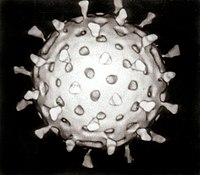
Photo from wikipedia
BACKGROUND Passive surveillance data are often the only available source of data that can be used to evaluate the population-level impact of vaccination, but such data often suffer from important… Click to show full abstract
BACKGROUND Passive surveillance data are often the only available source of data that can be used to evaluate the population-level impact of vaccination, but such data often suffer from important limitations such as changes in surveillance efforts. This study provides an example of how to identify important signatures of rotavirus vaccine impact, including evaluating the overall effectiveness and changes in rotavirus seasonal dynamics. METHODS We used data from a standardized sentinel rotavirus surveillance network in six Latin American countries (Bolivia, El Salvador, Guatemala, Honduras, Paraguay, and Venezuela) from 2004 to 2017. A random-effects model was used to evaluate changes in the proportion of rotavirus-associated hospitalizations following vaccine introduction. Harmonic regression models were used to estimate vaccine impact on the number of rotavirus hospitalizations, controlling for trends in rotavirus-negative cases. Changes to rotavirus seasonality were evaluated using center of gravity analysis, wavelet analysis, and harmonic regression. RESULTS All countries observed declines in the proportion of rotavirus-positive acute diarrhea samples with a mean reduction of 16% (95% confidence interval: 10-22%). We estimate that each 10% increase in vaccine coverage was associated with declines in the number of rotavirus-positive cases, ranging from 4.3% (1.3-7.2%) in Honduras to 21.4% (16.8-25.9%) in Venezuela. The strength of the seasonal peak in rotavirus incidence became smaller after vaccine introduction in Guatemala, Honduras, and Venezuela. Seasonal peaks also shifted later in the surveillance year, especially in higher-mortality countries. CONCLUSIONS The combination of methods we applied have different strengths that allow us to identify common signatures of rotavirus vaccine impact.
Journal Title: Vaccine
Year Published: 2019
Link to full text (if available)
Share on Social Media: Sign Up to like & get
recommendations!